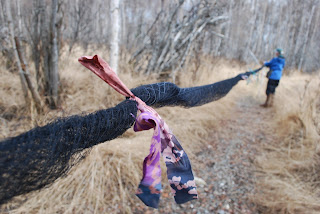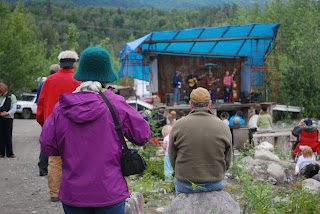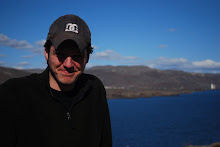I drove up to the old barnhouse at 5:32 a.m. Only 2 minutes late. Not bad. But I can’t ever seem to make it by 5:30. I never thought I’d be driving to work so early that I’d be the only car on the road. It helps that the sun has already crept over the horizon.
I meet my co-workers who are waiting on the stairs of the barnhouse/visitors center. We start walking toward the forest. The six of us walk together along the perfectly straight edge of the golden barley fields toward the trees where the mist-nets and banding tent are hidden from sight. The autumn colors of yellow and orange leap from the aspen and birch trees produce a strong contrast against the always green spruce.
There’s frost on the ground again today. We are all dressed for the cold. Layers - the only way to dress in Fairbanks. I have on long-johns, four shirts, wool socks, hat, gloves and coat. The temperature quickly rises once the sun gets high in the sky. I’ll likely strip off everything but my t-shirt by closing. Although it’s well below freezing now, it will be in the mid seventies by afternoon.
Thousands of sand hill cranes make a deafening roar flying overhead as we approach treeline. There’s an endless stream of these prehistoric creatures flying in perfect formation toward the barley. The noise – which always reminds me of dinosaur chatter – causes me to look up and appreciate the beautiful vibrant morning sky. Dawn has painted the normally plain white cloud ceiling a magnificent splash of orange, red and purple.
These abandoned fields are a staging ground for migrating birds. The cranes come in at nearly the same time every morning to rest and rebuild energy reserves (i.e. get fat) before continuing down to their wintering grounds in Texas/Mexico. Yesterday Fish and Game counted 1,800 cranes in our field. The crane arrival is so predictable, and so well received by the town, that there is an annual crane festival in their honor. There are lots of other birds that also stop in Fairbanks along their migration route - which is why I’m here. I work for the Alaska Bird Observatory. This is the 19th year that the non-profit has maintained the most northern banding station on the continent to collect data on migratory songbirds.
Once we reached the banding tent we all fanned-out into the woods to open the mist nets. There are 30 nets scattered throughout the forest. A mist net is a trap we use to catch the birds. It looks like a volleyball net that stretches all the way to the ground. The banding station provides an opportunity to learn a great deal about the current state of the migrating songbird populations as well as the condition of the birds southern wintering site, and breeding site (here in Alaska).
We often process 200-300 birds a day during spring migration. We only keep each bird long enough to take measurements and put a numbered band around its ankle. Although each individual bird is only in the area a few days - to rest and fatten up for the long trip south - there is a continuous flood of different flocks and species stopping in the Fairbanks area throughout the season.
After the nets are all open, we make regular checks to extract birds. I walked out of the banding tent to make my first net run and noticed the orange-red glow of dawn had been replaced by the bright yellow shine of morning. I weaved through the trees along the single-track dirt path with a pocket full of bird bags and a golf club in my hand (to pull down the net). As I walked away from net 29 I carried 2 bags on a string around my neck. Each bag had a bird I had just extracted. Before I even turned the corner to see net 30, the last net, I could hear all the commotion. As I got my first glimpse of the net, I was shocked by how visible it was. Usually the mist nets are nearly invisible. Now, with 49 birds crammed side-by-side from top-to-bottom, the net was as obvious as a brick wall.
I immediately went to work on the birds in the bottom panel, the ones most vulnerable near the ground. The final bird in the net was a Hermit Thrush 2 feet above my head in the top panel. With my face up to the sky I reached above my head to steady the bird with my left hand. As my right hand attempted to untangle her wing I felt something very warm and wet land square in the middle of my forehead. She pooped on me!!!
Creamer's Field Bird Sanctuary


 Judy extracting a dark-eyed Junco
Judy extracting a dark-eyed JuncoWilson's Warbler
Sharp-shinned Hawks often get caught chasing their food...song birds






 Autumn
Autumn




 Todd taking pictures of a calving glacier
Todd taking pictures of a calving glacier Off-trail hike in Denali National Park with the family
Off-trail hike in Denali National Park with the family Brooke carfefully negotiating a sandy drainage wall.
Brooke carfefully negotiating a sandy drainage wall. Mom and Brooke talking stategy.
Mom and Brooke talking stategy. Our hike down from Polychrome Moutnain.
Our hike down from Polychrome Moutnain. Todd and I begining Crow Pass hike (26 miles/13 hours)
Todd and I begining Crow Pass hike (26 miles/13 hours) Climbing up Crow Pass
Climbing up Crow Pass Veiw from the pass
Veiw from the pass

 How we spent most of the first leg of the hike.
How we spent most of the first leg of the hike. Overnight trip to the Bananza Mines in Wrangell - St. Elias N.P. with Daveen, Bonnie and Austin. Hiding from the rain under the ruins of an abandoned building/deck.
Overnight trip to the Bananza Mines in Wrangell - St. Elias N.P. with Daveen, Bonnie and Austin. Hiding from the rain under the ruins of an abandoned building/deck.

 Kennicott Mines.
Kennicott Mines.








 The Perch (22 miles out)
The Perch (22 miles out)
 Beautiful girls admiring a beautiful baby (17 days old)
Beautiful girls admiring a beautiful baby (17 days old) Campground Pickin
Campground Pickin






